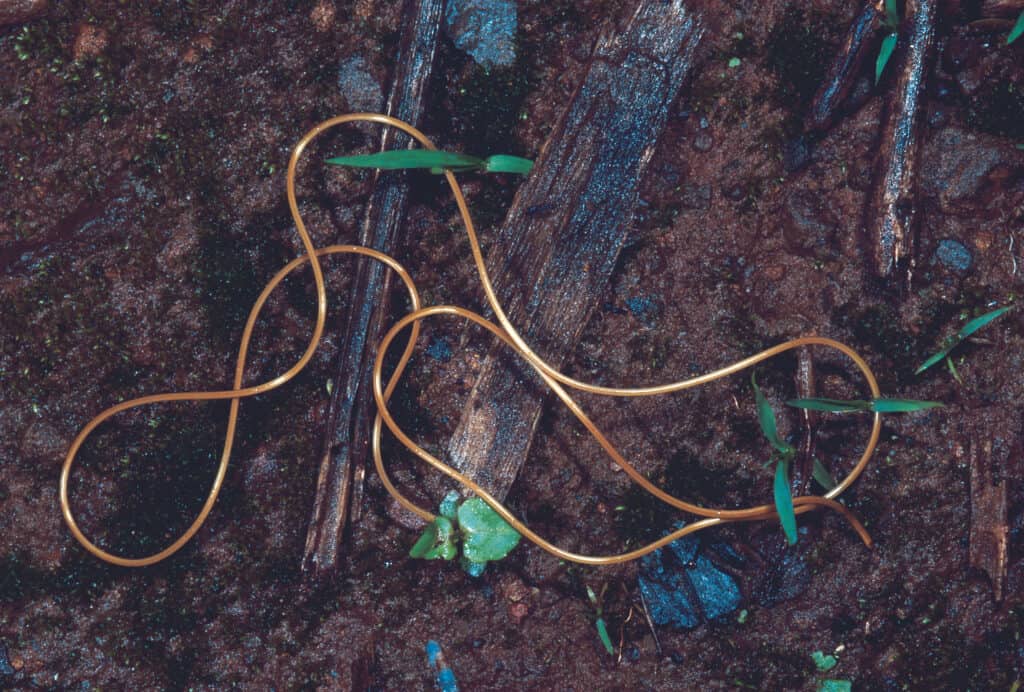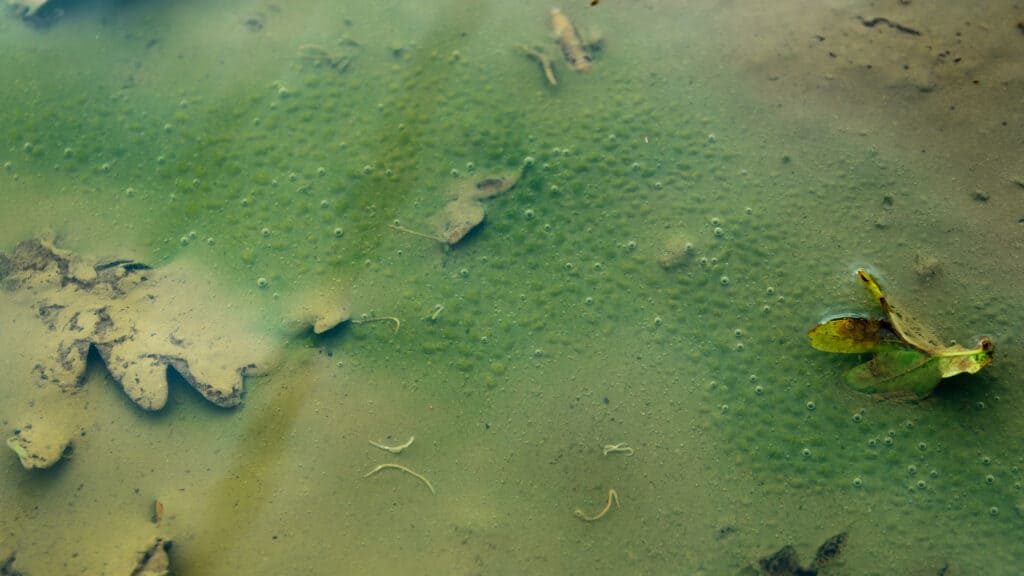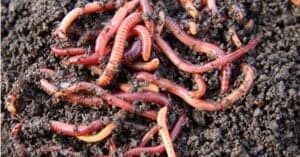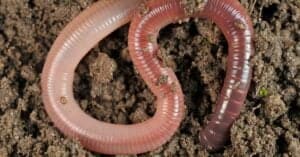Have you ever heard the story of a horse hair that fell into the water and became a worm? That’s what we’re talking about today – the worm that looks like a strand of hair! But was it really a strand of horsehair in its previous life?
Let’s see what studies show. But first, let’s learn more about this long bug.
The Bug That Looks Like a Strand of Hair

The bug that looks like a strand of hair is scientifically called
Nematomorpha.
©iStock.com/ePhotocorp
The bug that looks like a strand of hair is scientifically called Nematomorpha. The term refers to a phylum in the Nematoida clade and includes the worms people call horsehair worms, Gordian worms, or hairsnakes. There are more than 300 freshwater hairsnake species known to scientists. However, studies suggest an estimate of 2,000 freshwater species around the world.
While larvae are considered parasitic on beetles, mantises, cockroaches, crustaceans, and orthopterans, the adults are free-living, inhabiting streams, puddles, swimming pools, and cisterns. A “popular” misconception about these creatures is that they appeared from horse hairs that had fallen into the water. However, this has no scientific backup, especially since horsehair worms parasitize only invertebrates.
What Do Nematomorphs Look Like?
Nematomorphs have only one longitudinal muscle and a non-functional gut. They don’t have respiratory, circulatory, or excretory systems. However, they have a nervous system consisting of a ventral nerve cord that runs along the body and a nerve ring near the animal’s anterior end.
These animals typically grow between 2-and 3.9 inches long and up to 6.5 feet long in extreme cases, and they are 0.03-0.1 inches in diameter. Their bodies can be of various colors ranging from tan to black. The adults are covered in a thick, two-layered cuticle.
One unique thing about nematomorphs is that adults do not eat anything! While larvae feed on their hosts’ body tissues, adults only sometimes absorb nutrients from the water. Other than that, no food for nematomorph adults!
Nematomorphs: Similarity To Other Creatures
People often mistake nematomorphs for nematodes. However, the former are distinguished from the latter through the presence of a terminal cloaca. Another difference is that while horsehair worms require a host to mature, some nematodes do not rely on hosts to complete their lifecycle. We can also tell them apart by the fact that horsehair worms usually kill their hosts when they emerge from their bodies as adults. In contrast, nematodes do not aim to kill their hosts. However, these two are still closely related to each other.
Moreover, nematomorph larvae resemble adult invertebrates in the Kinorhyncha phylum of marine creatures living in mud or sand. These invertebrates are also called mud dragons.
Some sources show that the larvae look similar to some Loricifera (microscopic marine cycloneuralian sediment-dwelling animals) and Priapulida (marine worms, also known as penis worms) species.
Horsehair Worm Life Cycle

Horsehair worm eggs are laid on vegetation near water or in sticky strings underwater.
©iStock.com/Marek Polewski
Horsehair worm eggs are laid on vegetation near water or in sticky strings underwater. This depends on the horsehair worm species. The larvae need to be ingested by the host to continue their development. They’re most often ingested by their hosts when they eat vegetation or drink the water the larvae are in. Some species can infect mantids through intermediate hosts like mayflies or mosquitoes. These insects transport the larvae from aquatic environments to terrestrial habitats. Other species in the Nectonema genus are capable of infecting crustaceans underwater.
Moreover, besides being ingested by their hosts, some larvae species have a sharp appendage they can use to penetrate host body tissue. This way, they get inside their hosts’ bodies and start feeding on the nutrients by absorbing them through their skin.
Here’s an interesting fact! It’s believed that horsehair worms can influence their hosts’ nervous systems! How? Easy! Since they need to be near water before emerging as adults, horsehair worms are said to alter their hosts’ behavior to make them continuously look for water. Some species can even force grasshoppers and crickets to jump into the water and drown!
Can Horsehair Worms Infect Humans?
Theoretically, horsehair worms cannot parasitize vertebrate hosts, so they’re harmless to humans, pets, or livestock. However, a study focused on two human cases infected by the horsehair worm – an 80-year-old woman and a 1-year-old boy. The woman was lying in bed when she felt something caught in her throat. It reportedly happened after the woman had gargled with a saline solution. The worm measured 5.1 inches long. As for the boy, the mother collected it from her son’s mouth. This worm was 4.9 inches long.
The worms in both hosts were males and were identified as Parachordodes sp. They had cylindrical black-brown bodies. The scientists indicated that the hosts may have accidentally swallowed infected hosts, thus becoming infected with horsehair worms.
Research suggests that human accidental parasitism is uncommon in scientific literature, hence the recognized idea that humans can’t get infected. However, many specimens have been collected in recent years from humans’ anuses, urethras, or mouths.
Can Pets Get Horsehair Worms?
Horsehair worms won’t harm animals, including people, pets, or birds. They can’t infect plants either. Even if let’s say your curious dog accidentally swallows one or a few of them, it might cause slight discomfort in the stomach, but they can’t actually infect our furry pets or us as mentioned above.
You can identify a Horsehair worm by inspecting if they are initially white when it comes out of its host, but it will change color over time to a yellowish-tan or brownish-black soon after. These worms often wriggle and coil in water, forming a loose, ball-like shape that looks like a “Gordian Knot.”
That’s why they are also known as Gordian worms.
Are Horsehair Worms Dangerous?
No, horsehair worms aren’t considered dangerous to people, pets, and other vertebrates. Although you may find some around your house, there’s nothing to worry about. It’s generally recommended to clean the swimming pools and ponds around your house regularly. Some people find horsehair worms in their pets’ water bowls, so ensure to clean and disinfect them, too. Other than that, horsehair worms are pretty innocent!
The photo featured at the top of this post is © iStock.com/ePhotocorp
Sources
- Animal Diversity Web, Available here: https://animaldiversity.org/accounts/Nematomorpha/
- National Library of Medicine, Available here: https://www.ncbi.nlm.nih.gov/pmc/articles/PMC3428576/
- Missouri Department of Conservation, Available here: https://mdc.mo.gov/discover-nature/field-guide/horsehair-worms
Thank you for reading! Have some feedback for us? Contact the AZ Animals editorial team.






